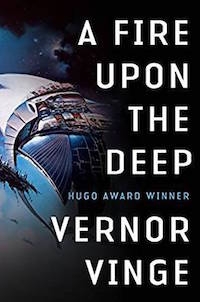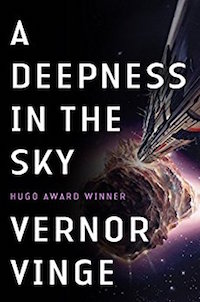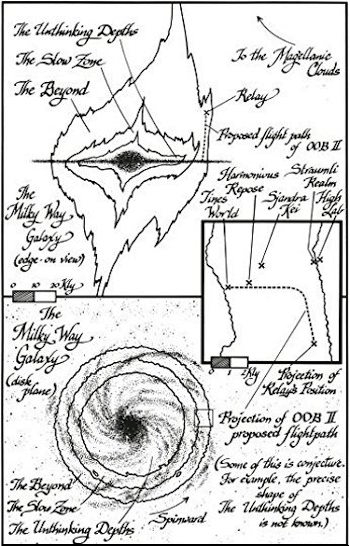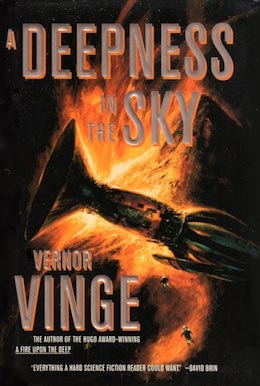In this bi-weekly series reviewing classic science fiction and fantasy books, Alan Brown looks at the front lines and frontiers of the field; books about soldiers and spacers, scientists and engineers, explorers and adventurers. Stories full of what Shakespeare used to refer to as “alarums and excursions”: battles, chases, clashes, and the stuff of excitement.
A Deepness in the Sky is one of those books that has it all: science that boggles the imagination; first contact with a singularly alien race; a fight for survival while trapped in a hostile environment; intrigue, betrayal, plots, counter-plots and revolution, even love stories. It’s no wonder the book won the Hugo in 1999—it’s one of those rare prequels that equals, if not surpasses, the excellence of the original.
But First, A Word from Our Sponsors
Before I discuss the book at hand, I’d like to point your attention back to the blurb in italics that leads the column. I imagine a lot of you skipped it, as it has remained the same for over a year. But there are some subtle changes this time around. Going forward, the column will be appearing bi-weekly instead of monthly. The scope has also been expanded a bit. I will be looking from time to time at fantasy books as well as science fiction, and the mention of engineers and scientists indicates that hard science fiction will also be part of my scope. The core of what I look at will still be action- and adventure-oriented stories that I have encountered over the years, and what I review will still be curated by going down into my basement and rummaging around (I told my wife all those books would come in handy someday…). And of course I will continue to provide information about the authors, the history and science that underlies the stories, and if applicable, the historical context in which the book was written, going forward.
The Curse of the Prequel
 In keeping with the idea of doing new things, this column marks the first time I have revisited an author’s work. I reviewed A Fire Upon the Deep, by Vernor Vinge, a few months ago. If you didn’t read that column, and want to know more about the previous book, the author, and his concept of the Zones of Thought, you can find it here. I dearly loved A Fire Upon the Deep when I first read it, but knowing that Vinge works slowly, I also knew that, if he planned to revisit its setting, it would take a while. Eventually, when I started hearing news of the new book and the fact that it was a prequel, I was concerned. There would be none of the Tines (the alien race that I found so fascinating in the previous book), and no continuation of the story I had so enjoyed. Instead, the new work would be set millennia before the previous book, with the only character in common being Pham Nuwen.
In keeping with the idea of doing new things, this column marks the first time I have revisited an author’s work. I reviewed A Fire Upon the Deep, by Vernor Vinge, a few months ago. If you didn’t read that column, and want to know more about the previous book, the author, and his concept of the Zones of Thought, you can find it here. I dearly loved A Fire Upon the Deep when I first read it, but knowing that Vinge works slowly, I also knew that, if he planned to revisit its setting, it would take a while. Eventually, when I started hearing news of the new book and the fact that it was a prequel, I was concerned. There would be none of the Tines (the alien race that I found so fascinating in the previous book), and no continuation of the story I had so enjoyed. Instead, the new work would be set millennia before the previous book, with the only character in common being Pham Nuwen.
All writers, especially science fiction writers, spend a lot of time on backstory. They map out where the characters came from, the scope of their previous adventures, what historical events preceded the narrative, and what scientific advances led to the technology described in the tale. Like an iceberg, while some of this effort is visible in the finished work, the vast majority of it remains unseen, filling the author’s notebooks. But the natural temptation is to share that information, and many authors, rather than producing a direct sequel to a popular book, choose to give us a prequel. These works are often less successful than the original; knowing which characters survive reduces the sense of jeopardy and narrative tension. The new work often refers to the preceding book in ways that keep it from standing on its own. The often-maligned Star Wars prequel movies are a good example of the perils involved in taking backstory, fleshing it out, and presenting it to the public.
But of course, Vinge did an outstanding job of avoiding those pitfalls. In A Fire Upon the Deep, when we meet Pham Nuwen, he is presented as the resurrected crew member of a Slow Zone spaceship owned by the Qeng Ho trading organization, brought back to life by a transcendent being known as the “Old One.” Thus, we don’t know if our hero will survive his adventures in the prequel, and the narrative tension survives intact. Plus, Vinge crafted the new novel so nothing presented in the previous book is necessary information for readers of the new book—one could read the books in chronological order based on the narrative, and find it just as satisfying as reading them in the order they were written. The reader doesn’t need to know anything about Vinge’s Zones of Thought to enjoy this new book, as it takes place entirely in the Slow Zone, where the speed of light limits travel and communications, and automated intelligences are also limited. Some of the themes resonate more deeply if you have read the previous book, but A Deepness in the Sky stands on its own as a complete, satisfying and independent work. In the end, Vinge completely avoided the curse that has burdened so many prequels.
A Deepness in the Sky
 The book begins with a Qeng Ho fleet’s arrival at the planet Triland to re-provision for an expedition to the OnOff star—an odd variable star system with intelligent non-human inhabitants, which flares back into life for a few decades after centuries of darkness. The Fleet Captain has another goal, as well. He has been pursuing news of the Man, a revered figure among the Qeng Ho. And on Triland, he finds him, aged and broken. He then convinces the Man to accompany the mission with a description of the mysteries they will be exploring, the fleet he commands, and the name of his flagship: the Pham Nuwen.
The book begins with a Qeng Ho fleet’s arrival at the planet Triland to re-provision for an expedition to the OnOff star—an odd variable star system with intelligent non-human inhabitants, which flares back into life for a few decades after centuries of darkness. The Fleet Captain has another goal, as well. He has been pursuing news of the Man, a revered figure among the Qeng Ho. And on Triland, he finds him, aged and broken. He then convinces the Man to accompany the mission with a description of the mysteries they will be exploring, the fleet he commands, and the name of his flagship: the Pham Nuwen.
The Qeng Ho fleet has rivals who will arrive at the OnOff star at about the same time. These humans, the Emergents, are from a system rebuilding after disaster, and share the basic knowledge the Qeng Ho have been broadcasting to help promote civilization and trade. We meet Trixia Bonsol, a young woman from Triland who has joined the Qeng Ho expedition, and her boyfriend Ezr Vinh, a young heir to one of the Qeng Ho families that own the expedition. We meet Pham Trinli, an ancient Qeng Ho armsman, and Qiwi Lisolet, a young Qeng Ho girl genius who is both a friend and irritant to Ezr. The first meetings show the Emergents to be an odd group. They are led by Tomas Nau, and their Programmer-at-Arms, or security chief, is a man named Rister Brughel. Emergent artwork is especially unsettling, prizing obsessive detail over form or style, and their society appears hierarchal and rigid.
Ezr finds himself called into a council of senior Qeng Ho leadership, who are deadlocked. They don’t trust the Emergents, but are unwilling to abandon the prize that this strange world represents. They can cut and run, they can preemptively attack the Emergents, or they can continue on but prepare against potential betrayal by their partners. Ezr casts the deciding vote, to stay but be ready for betrayal. When the attack comes, however, it is even more vicious than the Qeng Ho had imagined, and an engineered disease cripples their forces. The Emergents, however, have also met with more damage than they anticipated, and while they are victorious, they are now dependent on cooperation with the Qeng Ho to survive. The humans must now utilize the suspended animation technology they depend on during their slower-than-light travel to wait until the star reignites, and hope the alien inhabitant’s technology can help them get home.
The system they have arrived at is a strange one, not just because of its variable star. There is only one planet, and what few asteroids exist are composed of diamond. They name the planet Arachne, after its spider-like inhabitants, who are on the cusp of developing atomic power. The inhabitants hibernate in a nest they call a “deepness” during the frozen centuries, during which even the atmosphere freezes, then explode into activity and warfare during the warm decades. As the humans are arriving in the system, an Arachne genius named Sherkaner Underhill, from a nation called the “Accord,” has developed a type of spacesuit that allows movement during the cold. He and a military team use it to spread a black compound over a key enemy military depot, which concentrates sunlight when the star reignites and destroys the supplies. He becomes a hero, and is given carte blanche to develop new technologies. He is assisted in this effort by a Sergeant Unnerby, his companion in the daring raid, and an engineering and logistical genius in his own right. Underhill also marries the head of the Accord’s military intelligence, Victory Smith, further strengthening his ability to reshape society. His vision is to use advances like nuclear power to free the Arachne from the cycles of light and darkness, allowing their civilization to thrive even during the dark centuries—and even to escape the planet itself, to find “a deepness in the sky.”
On the human ships, the Qeng Ho find that the Emergents’ engineered disease has other, even more sinister applications. People can be “Focused,” and converted into human computing machines, which the Emergents use as simply another layer of their automated systems. Young Ezr is one of the senior surviving Qeng Ho leaders, and is blackmailed into acting as a go-between for the Emergents. He finds that his beloved Trixia has been Focused, and turned into a translator for the Arachne language. The Emergent who leads this process, Anne Reynolt, promises him that the process can be reversed, and uses Trixia to gain Ezr’s unwilling cooperation. Young Qiwi is manipulated into becoming a concubine of Tomas Nau, unaware that he and Rister Brughel are even more sadistic than anyone outside the Emergents could imagine.
On the planet, Sherkaner and Victory start a large family. The previous tradition had been to only bear children at the beginning of a light period, as youngsters did not do well during hibernation. This practice had developed into a religious taboo, which Sherkaner thinks is obsolete because people will remain active into the next dark phase. He starts a radio show to encourage science, featuring his children. When it is discovered that the children are off phase, he agrees to a debate between himself and a religious fanatic named Honored Pedure. The debate goes badly, and they find that she is an agent high in the government of a rival nation. In addition to nuclear power, the Arachne develop nuclear arms, and they head toward the next twilight period balanced on a powder keg of national rivalry and religious conflict.
In orbit, there is continuing turmoil between the Emergents and Qeng Ho, as each side jockeys for power. We find that Pham Trinli is much older and more capable than he seems, with knowledge of powers and abilities embedded deep in the software code of the Qeng Ho systems. Eventually, he and Ezr begin to plot rebellion. Both Pham and the Emergents underestimate the other’s capabilities, and both sides are constantly flirting with disaster. We see flashbacks to Pham’s younger days, and learn a lot more about him and the Qeng Ho in the process. Once the Arachne civilization begins to develop advanced technology, and the humans reach out to contact them, everything seems to be coming to a head; while the Qeng Ho look forward to trade, the Emergents look forward to conquest.
With the humans in space and the Arachne on the planet torn by internal strife, and all sides on a collision course with the others, the story barrels toward its conclusion while the reader turns the pages with ever-growing anticipation…
Ideas and Inspirations
In looking for the source of Vinge’s ideas, I searched for information on variable stars, and while I did not find descriptions of any that exactly matched the OnOff star, I found that there are a lot of peculiar orbs out there, and a lot more strangeness than I anticipated.

Because of the state of Arachne technology, I saw a strong connection with World War II, and immediately imagined Unnerby as an analog for General Leslie Groves, the engineer who coordinated the Manhattan Project. Because my father worked with atomic power, he had a deep library of books on the topic, and I learned more than a little about the effort. Furthermore, the Emergent’s Focused reminded me of a picture of a roomful of women at Los Alamos with adding machines, forming the components of a kind of human computer. And speaking of World War II, it is impossible to consider the Emergents without seeing parallels with the Nazis, with their fascistic society and human enslavement. The oppression and control of other people becomes a major theme to the book.
At first, I was disappointed by the portrayal of the Arachne. They seemed nothing more than anthropomorphic spiders, much less alien than the fascinating Tines and Skroderiders from A Fire Upon the Deep. But in the end, this sympathetic portrayal turns out to be a major point in the plot, and the Arachne turn out to be both more complex and more alien than they originally appear. Moreover, the tension between tradition and scientific advancement is well explored as the Arachne civilization develops.
While the book takes place in the Slow Zone, there are tantalizing hints of Transcendent technology, and intimations that there are greater possibilities to the universe than any of the characters can imagine. The substance “cavorite,” discovered by the Arachne, is a connection to the strange technologies of the Transcend as well as a tip of the hat to the work of H. G. Wells.
The flashbacks to Pham’s early days with the Qeng Ho serve to deepen our understanding of both this book and A Fire Upon the Deep, further driving home the sense that the struggle to bring lasting civilization to the stars, and link them together in a stable environment which avoids the pitfalls of tyranny, is a noble but frustrating endeavor.
Final Thoughts
This book is a tour de force, and I found it had an even bigger impact the second time around—the rare prequel that worked, all on its own. And when I finished it, I found myself with that rare and delicious sense of disorientation that comes with an outstanding book, feeling like my mind had been stretched by the experience of reading it.
And now, as always, I turn the floor to you. What are your thoughts on the book and its themes? Was this one of those rare times that a prequel improved upon its predecessor?
Alan Brown has been a science fiction and fantasy fan for over five decades, especially fiction that deals with science, military matters, exploration and adventure.










